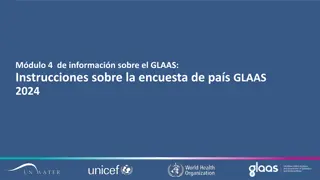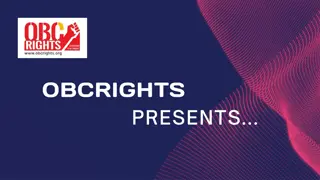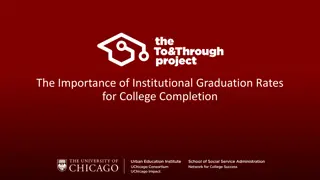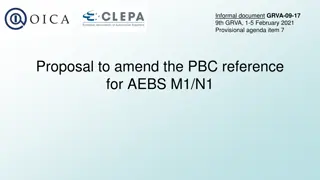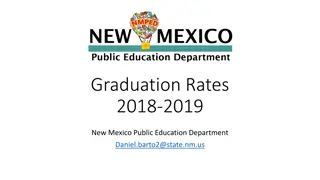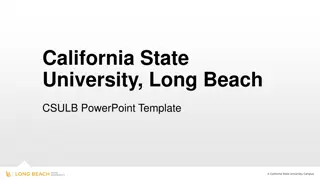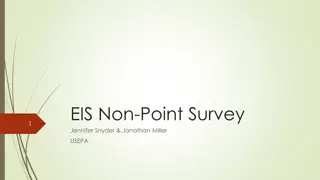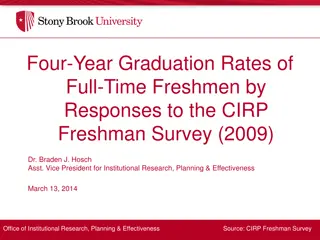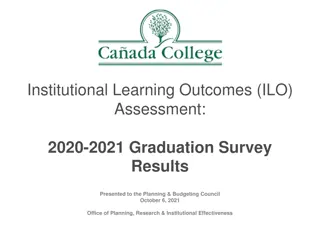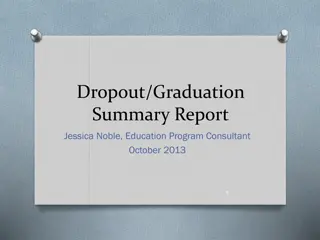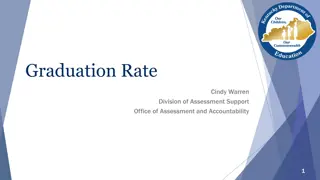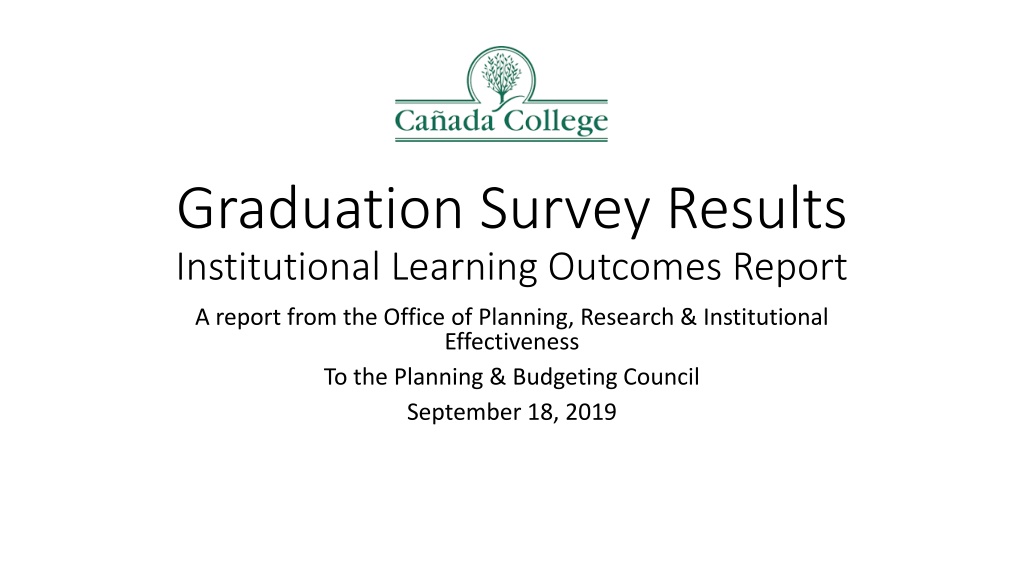
Graduation Survey Results: Institutional Learning Outcomes Report Analysis
Explore the key findings from a graduation survey report concerning institutional learning outcomes. Discover insights on respondent demographics, primary ethnicity, gender distribution, age groups, types of degrees earned, and students' self-assessment on practical problem-solving and critical thinking abilities.
Download Presentation

Please find below an Image/Link to download the presentation.
The content on the website is provided AS IS for your information and personal use only. It may not be sold, licensed, or shared on other websites without obtaining consent from the author. Download presentation by click this link. If you encounter any issues during the download, it is possible that the publisher has removed the file from their server.
E N D
Presentation Transcript
Graduation Survey Results Institutional Learning Outcomes Report A report from the Office of Planning, Research & Institutional Effectiveness To the Planning & Budgeting Council September 18, 2019
Respondents 92 out of 602 graduates 15% response rate 9% margin of error for a 95% confidence level
Primary ethnicity of survey respondents v. all graduates 70% 58% 60% 54% 50% 40% 30% 22% 21% 20% 10% 8% 8% 10% 4% 4% 4% 4% 3% 0% Asian Black Hispanic White Multi Race Other Survey Respondents Graduates
Primary Gender 90% 83% 80% 66% 70% 60% 50% 40% 31% 30% 17% 20% 10% 2% 0% 0% Male Female Other Survey Respondents All Graduates
Age of Respondents 30% 28% Average Age of Graduates: 30 25% 20% 14% 14% 15% 12% 12% 10% 7% 5% 4% 5% 3% 0% 0% Younger than 18 years old 18-19 20-22 23-25 26-30 31-35 36-40 41-50 51-60 60+
Type of Degree, Transfer, or Certificate (Mark all that apply) 40% 37% 37% 35% 34% of all graduates earn a certificate 30% 30% 27% 25% 20% 15% 11% 10% 5% 2% 0% AA AA-T AS AS-T Transfer without a Degree Certificate
I can apply theories or concepts to solving practical problems. 60% 51% 48% 50% 40% 30% 20% 10% 1% 0% 0% Strongly Agree Agree Disagree Strongly Disagree
I can analyze the basic elements of an argument, idea, or theory. 60% 51% 49% 50% 40% 30% 20% 10% 0% 0% 0% Strongly Agree Agree Disagree Strongly Disagree
I can select, evaluate, and use information to support a conclusion. 60% 55% 50% 45% 40% 30% 20% 10% 0% 0% 0% Strongly Agree Agree Disagree Strongly Disagree
I can draw from a variety of sources and inspirations to create unique, imaginative or innovative ideas or works. 60% 49% 48% 50% 40% 30% 20% 10% 2% 0% 0% Strongly Agree Agree Disagree Strongly Disagree
I can identify and evaluate multiple approaches to solving problems. 60% 51% 49% 50% 40% 30% 20% 10% 0% 0% 0% Strongly Agree Agree Disagree Strongly Disagree
I can apply the knowledge or skills that I acquired in one discipline to work that I do in another discipline. 60% 52% 50% 47% 40% 30% 20% 10% 1% 0% 0% Strongly Agree Agree Disagree Strongly Disagree
I can speak clearly and effectively to convey an idea or set of facts. 60% 51% 50% 47% 40% 30% 20% 10% 2% 0% 0% Strongly Agree Agree Disagree Strongly Disagree
I can write clearly and effectively to convey an idea or set of facts. 60% 54% 50% 45% 40% 30% 20% 10% 1% 0% 0% Strongly Agree Agree Disagree Strongly Disagree
I can find and evaluate sources of information and cite sources appropriately according to institutional and discipline standards. 60% 52% 50% 47% 40% 30% 20% 10% 1% 0% 0% Strongly Agree Agree Disagree Strongly Disagree
I can integrate ideas or information from a variety of sources into a document or report. 60% 51% 48% 50% 40% 30% 20% 10% 1% 0% 0% Strongly Agree Agree Disagree Strongly Disagree
I can understand the perspective of people who hold religious beliefs, political opinions, or personal values that substantially differ from my own. 57% 60% 50% 43% 40% 30% 20% 10% 0% 0% 0% Strongly Agree Agree Disagree Strongly Disagree
I can work effectively with diverse groups of people to accomplish a task or solve a problem. 70% 60% 60% 50% 40% 40% 30% 20% 10% 0% 0% 0% Strongly Agree Agree Disagree Strongly Disagree
I can identify the contributions of people from a different economic, social, racial or ethnic background than my own. 70% 62% 60% 50% 38% 40% 30% 20% 10% 0% 0% 0% Strongly Agree Agree Disagree Strongly Disagree
I can use equations to analyze and solve problems. 60% 51% 50% 40% 40% 30% 20% 9% 10% 0% 0% Strongly Agree Agree Disagree Strongly Disagree
I can make judgments and draw conclusions from data presented in graphs, tables, or diagrams. 60% 49% 50% 46% 40% 30% 20% 10% 4% 0% 0% Strongly Agree Agree Disagree Strongly Disagree
I can critically analyze whether data, presented in graphs, tables or diagrams, support appropriate conclusions. 60% 50% 50% 43% 40% 30% 20% 10% 7% 0% 0% Strongly Agree Agree Disagree Strongly Disagree


